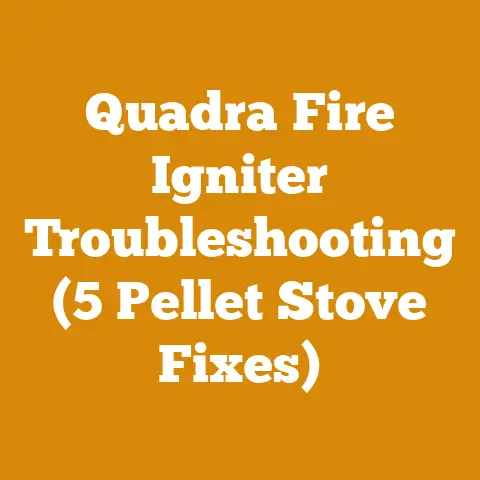Can You Burn Green Wood? (5 Pro Tips for Cleaner Combustion)
Imagine this: a crackling fire in a grand stone fireplace, casting a warm glow across a luxuriously appointed room.
The aroma of burning wood fills the air, a scent that speaks of comfort, tradition, and a connection to nature.
But what if that fire is stubbornly refusing to burn hot, spitting and sputtering instead of radiating warmth?
The culprit might be the very wood you’re using – green wood.
I’ve spent countless hours in the woods, felling trees, splitting logs, and preparing firewood.
I’ve learned the hard way that not all wood is created equal, and burning green wood is a recipe for frustration.
But don’t despair!
With the right knowledge and techniques, you can still coax a decent fire from less-than-ideal wood.
In this article, I’ll share my hard-earned wisdom on burning green wood, transforming a potential headache into a manageable situation.
I’ll delve into the science behind wood combustion, explain why green wood is problematic, and provide practical tips to help you achieve cleaner, more efficient burns.
Key Takeaways You’ll Learn:
- The Science of Wood Combustion: Understand how moisture content affects burning.
- Why Green Wood is Problematic: Learn the drawbacks of burning wood with high moisture content.
- 5 Pro Tips for Cleaner Combustion: Practical techniques to improve green wood burning.
- Wood Species and Drying Times: Gain insights into different wood types and their drying characteristics.
- Alternative Uses for Green Wood: Explore options beyond burning for freshly cut wood.
Can You Burn Green Wood? (5 Pro Tips for Cleaner Combustion)
Burning green wood is possible, but it’s far from ideal.
“Green wood” refers to wood that has been recently cut and hasn’t had time to dry or season.
This wood contains a high percentage of moisture, typically ranging from 30% to over 50% of its weight.
Seasoned firewood, on the other hand, ideally has a moisture content of 20% or less.
The high moisture content in green wood significantly impacts its ability to burn efficiently and cleanly.
The Science of Wood Combustion
To understand why green wood is problematic, let’s look at the science of wood combustion.
Burning wood is a three-stage process:
- Water Removal: The initial heat from the fire is used to evaporate the water within the wood.
This process absorbs energy, effectively cooling the fire. - Gasification: Once the water is gone, the wood heats up further, releasing volatile gases like methane, carbon monoxide, and hydrogen.
These gases are what actually burn and produce flames. - Charcoal Burning: After the gases are burned off, the remaining charcoal (carbon) burns, producing a steady, glowing heat.
Green wood throws a wrench into this process because a significant portion of the fire’s energy is spent evaporating water instead of gasifying the wood.
This leads to a cooler fire, incomplete combustion, and a host of other problems.
Why Green Wood is Problematic
Burning green wood comes with a range of drawbacks that affect both the efficiency and the safety of your fire.
- Reduced Heat Output: Because the fire’s energy is used to evaporate water, less energy is available to produce heat.
This means your fire won’t be as warm, and you’ll need to burn more wood to achieve the same level of warmth.
According to the U.S.
Department of Energy, burning seasoned wood can produce up to 50% more heat than burning green wood. - Smoky Fires: Incomplete combustion of volatile gases due to lower temperatures results in a smoky fire.
This smoke contains unburned hydrocarbons and particulate matter, which are both pollutants. - Increased Creosote Buildup: Creosote is a dark, oily, combustible substance that forms when wood smoke condenses in your chimney or stovepipe.
Burning green wood significantly increases creosote buildup.
Creosote is a major fire hazard, as it can ignite and cause a chimney fire.
The Chimney Safety Institute of America (CSIA) emphasizes the importance of burning seasoned wood to minimize creosote buildup and prevent chimney fires. - Difficult to Light and Keep Burning: Green wood is notoriously difficult to ignite and keep burning.
The high moisture content makes it resistant to catching fire, and the cooling effect of evaporation can extinguish the flames. - Environmental Impact: The smoky emissions from burning green wood contribute to air pollution and can be harmful to human health.
5 Pro Tips for Cleaner Combustion of Green Wood
While burning seasoned wood is always the best option, sometimes you might find yourself in a situation where you have no choice but to burn green wood.
Here are five pro tips to help you achieve cleaner combustion and minimize the negative effects:
Tip 1: Mix Green Wood with Seasoned Wood
The most effective way to burn green wood is to mix it with seasoned wood.
The seasoned wood will provide the necessary heat to help dry out and ignite the green wood.
- Layering Technique: Start with a base of dry kindling and seasoned wood.
Once the fire is established, gradually add pieces of green wood, alternating with seasoned wood.
This allows the green wood to slowly dry out and ignite without smothering the fire. - Pro Tip: Place the green wood around the edges of the fire, where it will be exposed to radiant heat but not directly in the flames.
This will help it dry out more efficiently.
Tip 2: Split the Green Wood Small
Smaller pieces of wood dry out faster and ignite more easily.
Splitting green wood into smaller pieces increases the surface area exposed to air, allowing moisture to evaporate more quickly.
- Ideal Size: Aim for pieces that are no more than 4-6 inches in diameter.
- Splitting Technique: Use a maul or splitting axe to split the wood along the grain.
If the wood is particularly tough, consider using a hydraulic log splitter. - Data Point: Research from the Forest Products Laboratory shows that splitting wood can reduce its drying time by up to 25%.
Tip 3: Pre-Heat the Green Wood
Before adding green wood to the fire, try pre-heating it near the flames.
This will help to evaporate some of the moisture and make it easier to ignite.
- Placement: Place the green wood on a rack or near the firebox, but not directly in the flames.
- Rotation: Rotate the wood periodically to ensure even heating.
- Caution: Be careful not to overheat the wood, as this can cause it to smolder and produce excessive smoke.
Tip 4: Ensure Adequate Airflow
Proper airflow is crucial for efficient combustion.
Make sure your fireplace or wood stove has adequate ventilation to supply the fire with enough oxygen.
- Damper Control: Adjust the damper to allow for optimal airflow.
Open the damper fully when starting the fire and gradually close it as the fire gets going. - Air Vents: Ensure that air vents are not blocked by ashes or debris.
- For Wood Stoves: Modern wood stoves often have adjustable air controls that allow you to fine-tune the airflow for optimal combustion.
According to the EPA, certified wood stoves are significantly more efficient and produce less pollution than older, non-certified models.
Tip 5: Burn Hotter Fires
Hotter fires are more efficient at burning off volatile gases and reducing smoke.
To achieve a hotter fire, use a combination of seasoned wood, proper airflow, and a well-established fire base.
- Fueling the Fire: Add small amounts of wood frequently to maintain a consistent flame.
Avoid overloading the firebox, as this can smother the fire and reduce airflow. - Wood Species: Consider using hardwoods like oak, maple, or ash, which have a higher energy content than softwoods like pine or fir.
Hardwoods burn hotter and longer, providing more heat and less smoke. - Temperature Monitoring: Use a stovepipe thermometer to monitor the temperature of your fire.
Aim for a temperature within the manufacturer’s recommended range for optimal combustion.
Wood Species and Drying Times
The type of wood you’re burning also plays a significant role in its drying time and burning characteristics.
Different wood species have varying densities and moisture contents, which affect how quickly they dry and how efficiently they burn.
- Hardwoods vs.
Softwoods: Hardwoods generally take longer to dry than softwoods due to their higher density.
However, hardwoods also burn hotter and longer, making them a better choice for sustained heat. - Drying Times: As a general rule, hardwoods like oak and maple can take 12-24 months to dry properly, while softwoods like pine and fir may only take 6-12 months.
- Popular Firewood Species:
- Oak: A dense hardwood that burns hot and long, producing excellent heat.
- Maple: Another excellent hardwood with similar burning characteristics to oak.
- Ash: A medium-density hardwood that splits easily and burns cleanly.
- Birch: A fast-drying hardwood that provides good heat but burns relatively quickly.
- Pine: A softwood that dries quickly and ignites easily, but burns quickly and produces more smoke.
Alternative Uses for Green Wood
If you have a large quantity of green wood that you can’t burn right away, consider these alternative uses:
- Woodworking: Green wood is easier to work with than seasoned wood, making it ideal for certain woodworking projects, such as carving, turning, and bending.
- Building Structures: Green wood can be used to build rustic structures like fences, sheds, and garden beds.
- Mushroom Cultivation: Some types of mushrooms thrive on freshly cut wood.
Inoculating green wood with mushroom spores can provide a sustainable source of food. - Composting: Green wood chips can be added to your compost pile to provide carbon and improve aeration.
- Hugelkultur: Hugelkultur is a gardening technique that involves burying large logs and branches to create raised beds.
The decaying wood provides nutrients and moisture to the soil.
Case Study: Optimizing Firewood Drying in a Small Workshop
I once consulted with a small woodworking shop in the Appalachian Mountains that relied heavily on firewood for heating.
They were struggling to keep up with demand and often had to burn green wood, resulting in inefficient heating and excessive smoke.
- The Challenge: The workshop lacked a proper drying area and had limited storage space.
They were cutting and burning wood on the same day, which led to poor combustion and increased creosote buildup. - The Solution: I helped them design a simple firewood drying rack using scrap lumber.
The rack was elevated off the ground and had good airflow on all sides.
We also implemented a system for rotating the firewood, ensuring that the oldest wood was burned first. - The Results: Within a few months, the workshop was able to burn mostly seasoned wood.
Their heating efficiency improved significantly, and they noticed a reduction in smoke and creosote buildup. - Key Takeaway: Even a small investment in proper firewood drying can yield significant benefits in terms of efficiency, safety, and environmental impact.
Addressing Common Concerns About Burning Green Wood
- “Will burning green wood damage my fireplace or wood stove?” Yes, burning green wood can damage your fireplace or wood stove over time due to increased creosote buildup.
Creosote can corrode metal components and increase the risk of chimney fires. - “Is it illegal to burn green wood?” In some areas, there may be regulations regarding the burning of green wood due to air quality concerns.
Check with your local authorities for specific regulations. - “How can I tell if my wood is dry enough to burn?” There are several ways to determine if your wood is dry enough to burn:
- Visual Inspection: Seasoned wood will be darker in color and have cracks or checks in the end grain.
- Weight: Seasoned wood will be significantly lighter than green wood.
- Sound: When you strike two pieces of seasoned wood together, they will produce a hollow sound.
Green wood will produce a dull thud. - Moisture Meter: A moisture meter is a device that measures the moisture content of wood.
Aim for a moisture content of 20% or less for optimal burning.
Conclusion: Burning Smarter, Not Harder
While burning green wood is not ideal, it is sometimes unavoidable.
By understanding the science of wood combustion and following the pro tips outlined in this article, you can minimize the negative effects and achieve cleaner, more efficient burns.
Remember to prioritize safety, ensure adequate airflow, and mix green wood with seasoned wood whenever possible.
Ultimately, the best approach is to plan ahead and season your firewood properly.
This will not only improve the efficiency of your fires but also reduce the risk of chimney fires and minimize your environmental impact.
Now, I encourage you to take action!
Start by assessing your current firewood supply and identifying any green wood that needs to be seasoned.
Build a simple drying rack, split your wood into smaller pieces, and start planning for next year’s firewood needs.
With a little effort and planning, you can enjoy the warmth and ambiance of a crackling fire without the hassle and drawbacks of burning green wood.






